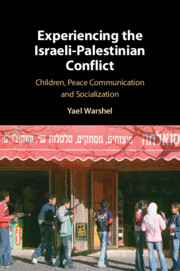Book contents
- Experiencing the Israeli-Palestinian Conflict
- Experiencing the Israeli-Palestinian Conflict
- Copyright page
- Dedication
- Contents
- Figures
- Tables
- Acknowledgments
- Note on the Text
- Abbreviations
- Introduction
- Part I The Encoding and Production of Israeli and Palestinian Sesame Street
- Introduction to Part I: Encoding and Production Methodologies
- 1 The Israeli-Palestinian Ethno-political Nationalist Conflict, the Arab-Israeli Multistate Conflict and Israeli and PalestinianSesame Street’s Disengagement with These Conflicts
- 2 The Modern World, or Interstate, System
- 3 The Encoding Process for Seasons One and Two of Israeli and Palestinian Sesame Street
- Part II Audience Reception of Israeli and Palestinian Sesame Street
- Part III Situating the Reception of Israeli and Palestinian Sesame Street in Mundane, Intractable Conflict Zone Practices
- Part IV Conclusions and Recommendations to Improve Peace Communication Research, (Evidence-Based) Practice and Conflict Intractability Interpretation
- Book part
- References
- Index
- Plate Section (PDF Only)
3 - The Encoding Process for Seasons One and Two of Israeli and Palestinian Sesame Street
from Part I - The Encoding and Production of Israeli and Palestinian Sesame Street
Published online by Cambridge University Press: 08 July 2021
- Experiencing the Israeli-Palestinian Conflict
- Experiencing the Israeli-Palestinian Conflict
- Copyright page
- Dedication
- Contents
- Figures
- Tables
- Acknowledgments
- Note on the Text
- Abbreviations
- Introduction
- Part I The Encoding and Production of Israeli and Palestinian Sesame Street
- Introduction to Part I: Encoding and Production Methodologies
- 1 The Israeli-Palestinian Ethno-political Nationalist Conflict, the Arab-Israeli Multistate Conflict and Israeli and PalestinianSesame Street’s Disengagement with These Conflicts
- 2 The Modern World, or Interstate, System
- 3 The Encoding Process for Seasons One and Two of Israeli and Palestinian Sesame Street
- Part II Audience Reception of Israeli and Palestinian Sesame Street
- Part III Situating the Reception of Israeli and Palestinian Sesame Street in Mundane, Intractable Conflict Zone Practices
- Part IV Conclusions and Recommendations to Improve Peace Communication Research, (Evidence-Based) Practice and Conflict Intractability Interpretation
- Book part
- References
- Index
- Plate Section (PDF Only)
Summary
The programs portrayed a utopian world, by resolving “the conflict” through the creation of the separate and newly independent Palestinian Street. Internally to it, they modeled and offered opportunties for the simulation of pro-social inter-“group” contact and friendship, including through targeted behavior change curricular components. This chapter describes the process of producing the series, from the intended encoding, or curriculum design, to the adapted encoding of the curriculum into a screenplay with characters, to the expressed encoding, the ultimate episodes edited together, to their broadcast and evolution over two seasons. The series satisfied the five contact hypothesis “requirements” for successfully reducing prejudice, including by substituting official support recommended for interpersonal encounters with the brand-name appeal of Sesame Workshop, together with Israeli and Palestinian elites’ approval of the series. As discussed in Part II, parents’ trust of the name may have helped boost children’s exposure. For decoding analyses, the author edited together a mock episode featuring the key elements necessary to compare the Palestinian, Jewish Israeli, and Arab/Palestinian Israeli children’s decodings against the producers’ encodings within the context of the Israeli-Palestinian ethno-political and Arab-Israeli multi-state conflicts
Keywords
- Type
- Chapter
- Information
- Experiencing the Israeli-Palestinian ConflictChildren, Peace Communication and Socialization, pp. 88 - 120Publisher: Cambridge University PressPrint publication year: 2021



